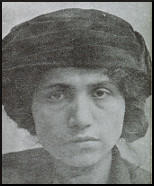Sara Trassjonsky

Sara Trassjonsky was born into a Jewish family in Poland. She lived in Paris before moving to London in 1909 where she worked in a tailor shop. Donald Rumbelow, the author of The Siege of Sidney Street (1973) has pointed out: "She (Sara) was showing increasing signs of mental instability. Part of her condition was certainly physical. Her right shoulder-blade was deformed, as was her left hip. She was a willing little creature and went to the shop readily enough."
Trassjonsky associated with a group of Russian revolutionaries that included George Gardstein, Peter Piaktow (Peter the Painter), Yakov Peters, Fritz Svaars, Yourka Dubof, Karl Hoffman, John Rosen, Max Smoller and William Sokolow. These men carried out several robberies and on 16th December 1910, the gang killed three policeman, Robert Bentley, Charles Tucker and Walter Choat. Gardstein was badly wounded in the clash with the police and was taken back to 59 Grove Street. Nina Vassilleva went to a doctor who she thought might help. He refused and threatened to tell the police.
Nina eventually persuaded Dr. John Scanlon, to treat Gardstein. He discovered that Gardstein had a bullet lodged in the front of the chest. Scanlon asked Gardstein what had happened. He claimed that he had been shot by accident by a friend. However, he refused to be taken to hospital and so Scanlon, after giving him some medicine to deaden the pain and receiving his fee of ten shillings, he left, promising to return later. Despite being nursed by Sara Trassjonsky, Gardstein died later that night.
When the police arrived Trassjonsky was busy burning incriminating documents. She was arrested and questioned at the City Police headquarters in Old Jewry, off Cheapside. However, they were unable to get any significant information from her.
The trial of the Houndsditch murders opened at the Old Bailey on 1st May. Yakov Peters and Yourka Dubof were charged with murder. Peters, Dubof, Karl Hoffman, Max Smoller and John Rosen were charged with attempting to rob Henry Harris's jeweller's shop. Sara Trassjonsky and Nina Vassilleva, were charged with harbouring a felon guilty of murder.
The opening speech of A. H. Bodkin lasted two and a quarter hours. He argued that George Gardstein killed Robert Bentley, Charles Tucker and Walter Choat and Smoller shot Gardstein by mistake. Justice William Grantham was unimpressed with the evidence presented and directed the jury to say that the two men, against whom there was no evidence of shooting, were not guilty of murder. Grantham added that he believed that the policeman were killed by George Gardstein, Fritz Svaars and William Sokolow. "There were three men firing shots and I think they are dead."
The prosecution's principal witness that linked Peters and Dubof to Gardstein was Isaac Levy, who saw the men drag him along Cutler Street. Levy came under a fierce attack from defence counsel. After his testimony, Justice Grantham said that if there was no other evidence of identification he could not allow any jury to find a verdict of guilty on Levy's uncorroborated statement. After Grantham's summing-up made it clear that none of the men should be convicted of breaking and entering, the jury found them all not guilty and they were set free.
Sara Trassjonsky was found not guilty and released. Nina Vassilleva was found guilty of conspiracy to commit a robbery but recommended that she should not be deported. Vassilleva was sentenced to two years' imprisonment, but five weeks later the Court of Appeal quashed her conviction on the ground of misdirection of the jury by Justice Grantham.
The mental condition of Sara Trassjonsky had deteriorated and she was sent to Colny Hatch Lunatic Asylum.
Primary Sources
(1) Donald Rumbelow, The Siege of Sidney Street (1973)
The doctor's visit to 59 Grove Street is unrecorded, but he must have seen the brooding figure of Sara Trassjonsky as well as the stiffening corpse. He got past the landlord and then, ignoring everything he had been told, telephoned the Coroner's Officer; it was either the Coroner's Officer or Dr Scanlon himself who then gave the story to the press. When he got back to the surgery he told the astounded policemen what he had done. They were furious and raced with several armed detectives to the house, reaching it only minutes before the reporters.
Mrs Katz - "a fat old Jewess" was Wensley's unflattering description - opened the door. She could not or would not understand their questions, not even when Wensley cut short her babble and pushed her up the stairs ahead of him, guessing that if there were armed men at the head of the stairs no power on earth would have got her up. (He reckoned that her ample bulk would protect him from any possible bullet, but her weight would have crushed him if she had fallen backwards!)
As the bedroom door swung open, he saw Gardstein lying on the bed with his eyes open, facing them. It was hard to believe that he was dead. He was lying there in a crumpled dark-grey suit and white shirt, with white stripe facings, pulled out at the waistband.
Detective Sergeant Benjamin Leeson, who had joined Wensley, pushed open the door of the back room. Sara Trassjonsky was thrusting more papers into the flames as he reached forward, his revolver ready, and seized the hunchbacked little woman by the wrist. She was hustled away to City Police headquarters in Old Jewry, off Cheapside, and policemen were stationed outside the house to keep out the reporters milling about on the pavement. A young man pushed through the small crowd and, ignoring the policeman outside, knocked on the door. When it was opened he asked for Fritz. His name, he told the astonished detectives, was Nicholas Tomacoff.
